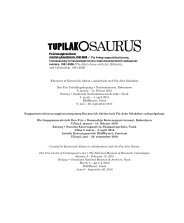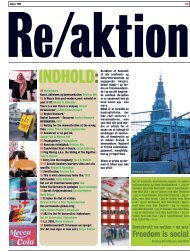tupilakosaurus - Print matters!
tupilakosaurus - Print matters!
tupilakosaurus - Print matters!
Create successful ePaper yourself
Turn your PDF publications into a flip-book with our unique Google optimized e-Paper software.
1993<br />
misigitippaatigut soorlu saqqummersitsiviup<br />
iluaniittugut. Soorlu “nujuartat”<br />
pillugit sarsuatitaliarpassuarnisut, uanili<br />
nujuillisarneqaqqissaakkatut takutinneqarlutik.<br />
Guutiusullu tamanna katersuuffigaat. Ini<br />
pinngortippaat, uagut isiginnaartuusugut<br />
unittariaqalersilluta – takunnillutalu.<br />
Isigikkit eqqarsaatimikkut inissisimaneri<br />
oqariartuutaallu qimerloorlugu.<br />
Eqqumiitsuliaq tunissuteqarpoq tigusillunilu.<br />
Isiginnaartuusugut attuumassuseqartutut<br />
misigitilluta. Susunnimik<br />
tammartikkuminaatsumik naasaqartilerluta.<br />
Eqqumiitsuliap isiginnaartoq<br />
sunniuteqarfigaa, ingerlaqqinnermini<br />
eqqarsaataanut sunniuteqarluni – pissutsillu<br />
pillugit oqariartuuteqalersillugu.<br />
Eqqumiitsuliortup oqariartuutaa tassani<br />
paarlaateqatigiinnermi pinngorpoq,<br />
Arkep eqqumiitsuliaani De tre Gratier<br />
erseqqinnerusinnaagani.<br />
Guutiusut akerleriillutik piviusuliamiipput<br />
eqqumiitsuliornikkut nunanut killernut<br />
nunanullu inuiaassutsimik aallaavilinnut<br />
tikkuussillutik. Eqqumiitsuliaq<br />
isummanut imminut assortuuttunut<br />
ilisarnaatinngorpoq, kalaallit eqqumiitsuliaani<br />
tamanna takussaagajuttarpoq, inuiaassutsimik<br />
aallaaveqarluni eqqumiitsuliaq<br />
nammineq saqqummernermini<br />
inuiaassutsimut ilisarnaatitut eqqumiitsuliatulluimikkoortikkuminaassilluni.<br />
Arkep De tre Gratier aqqutigalugit<br />
imminut isummatigut assortuunnerup<br />
atorunnaarsinnaanera periarfissippaa.<br />
Assigiinngitsutigut akerleriittutut inissisimanermigut<br />
eqqumiitsuliaq kulturimut<br />
aallaavimminut uteqqippoq – anersaamigullu.<br />
Isigisaq nikisinngikkaluarlugu,<br />
eqqarsaatilli angerlamut uterteqqinneqarput,<br />
pissaanerlu nunasiaatilinnit<br />
pigineqarunnaarluni nunasiaasimasunit<br />
pigineqalerluni.<br />
Guutiliat isiginnaartoq aggersarpaat,<br />
aalajangersimasuinnarli tikillugu. Soorlu<br />
igalaamerngup saqqummersitsivimmiittut<br />
takutitap attorneqarnissaannut<br />
assersortarai.<br />
Sara Olsvig<br />
Pia Arke. The Three Graces. 1993<br />
Should one embrace or reject? That’s<br />
what the Graces in Pia Arke’s photo<br />
work The Three Graces seem to be<br />
thinking. Reluctantly they hold objects<br />
that symbolise a special ethnicity<br />
and a special place of belonging. Reluctantly<br />
they let themselves be called<br />
“Graces” – three goddesses that in the<br />
Western art tradition represent such<br />
things as beauty, charm and creativity,<br />
and who were depicted absorbed<br />
in each other’s company and touching<br />
each other affectionately. Arke’s three<br />
Graces stand, in contrast, at a cool<br />
distance from one another, so that<br />
this obvious breach with the tradition<br />
becomes a visible sign of a showdown<br />
with the Western view of ethnic art.<br />
Just as reluctantly they seem to<br />
reveal a recognition that they are<br />
being used here as media for a state.<br />
The state of being between stages<br />
not in a hierarchical sense, but in<br />
an artistic sense. Of being between<br />
the stage where ethnographica are<br />
collected and exhibited as curiosities<br />
from distant regions for some more<br />
or less interested viewer, and the<br />
stage of being themselves – of being<br />
women in a modern world and art in<br />
a modern world at a time and in a<br />
place that are of no account.<br />
The Graces reflect themselves in<br />
themselves, then they turn their<br />
backs and eventually they stare at<br />
us. In so doing they make us – the<br />
viewers – the central factor in the<br />
work. They invite us to understand<br />
their standpoint.<br />
The photographs function as<br />
showcases in themselves. As when<br />
you are visiting an ethnographic<br />
museum looking at messages from<br />
the past filtered through the collector’s<br />
eye. Arke’s photos are clearly<br />
constructed in the same way, as<br />
small needles cut into bone or tooth,<br />
masks from different parts of a<br />
country, variations of pearl collars<br />
and skin trousers are laid out side<br />
by side behind the glass of the<br />
showcase. From this constructed<br />
reality the Graces takes the viewer<br />
towards a place that no longer exists.<br />
The photostat of a Greenland<br />
landscape in the background and<br />
the angle from which the picture<br />
was taken give a sense of being on<br />
a stage. As in one of the scenes in<br />
the innumerable films about “the<br />
savages”, but here domesticated<br />
down to the smallest detail.<br />
The Graces gather around this<br />
place. They create the space in<br />
which we viewers are forced to stop<br />
– and look. Look at them and view<br />
their standpoint and message.<br />
The work gives and it takes. It<br />
gives the viewer a sense of belonging.<br />
A taste in one’s mouth that<br />
cannot immediately be rinsed<br />
away. The work sets its mark<br />
on the viewer, and the viewer<br />
wanders on in her or his world<br />
enriched by this emotion – as a<br />
messenger for a state. The artist’s<br />
message is formed in this<br />
exchange, a relation that could<br />
not be depicted more clearly than<br />
Arke does in The Three Graces.<br />
There is a contradiction in the way<br />
the Graces in their constructed reality<br />
signal links both to Western<br />
art and to traditional ethnic art.<br />
The work becomes a symbol of the<br />
ambivalence that often envelops<br />
modern Greenlandic art, in which<br />
the ethnic expression in some contexts<br />
makes the object something<br />
in between ethnographica and<br />
art. With The Three Graces Arke<br />
succeeds in creating a space where<br />
there is no ambivalence. By being<br />
self-contradictory at a number<br />
of levels the work becomes an<br />
expression of the artist’s repatriation<br />
of art to her own culture – but<br />
at an existential level. Without<br />
the object being moved, it is the<br />
thoughts that are moved home<br />
and the power relation changes<br />
from having belonged to the colonial<br />
power to now belonging to the<br />
person who was colonised.<br />
Quietly the Graces allow the<br />
viewer to approach, but only to a<br />
certain point. As when the glass<br />
naturally rejects the touching of<br />
the objects in a showcase.<br />
Sara Olsvig<br />
35




